- Home
- ABOUT US
- Shiseido Talks
- Addressing True Barriers That Face Female Researchers in Japan — Envisioning the Future of the Shiseido Female Researcher Science Grant in the 15th Year of Establishment
Addressing True Barriers That Face Female Researchers in Japan — Envisioning the Future of the Shiseido Female Researcher Science Grant in the 15th Year of Establishment
November 10, 2021
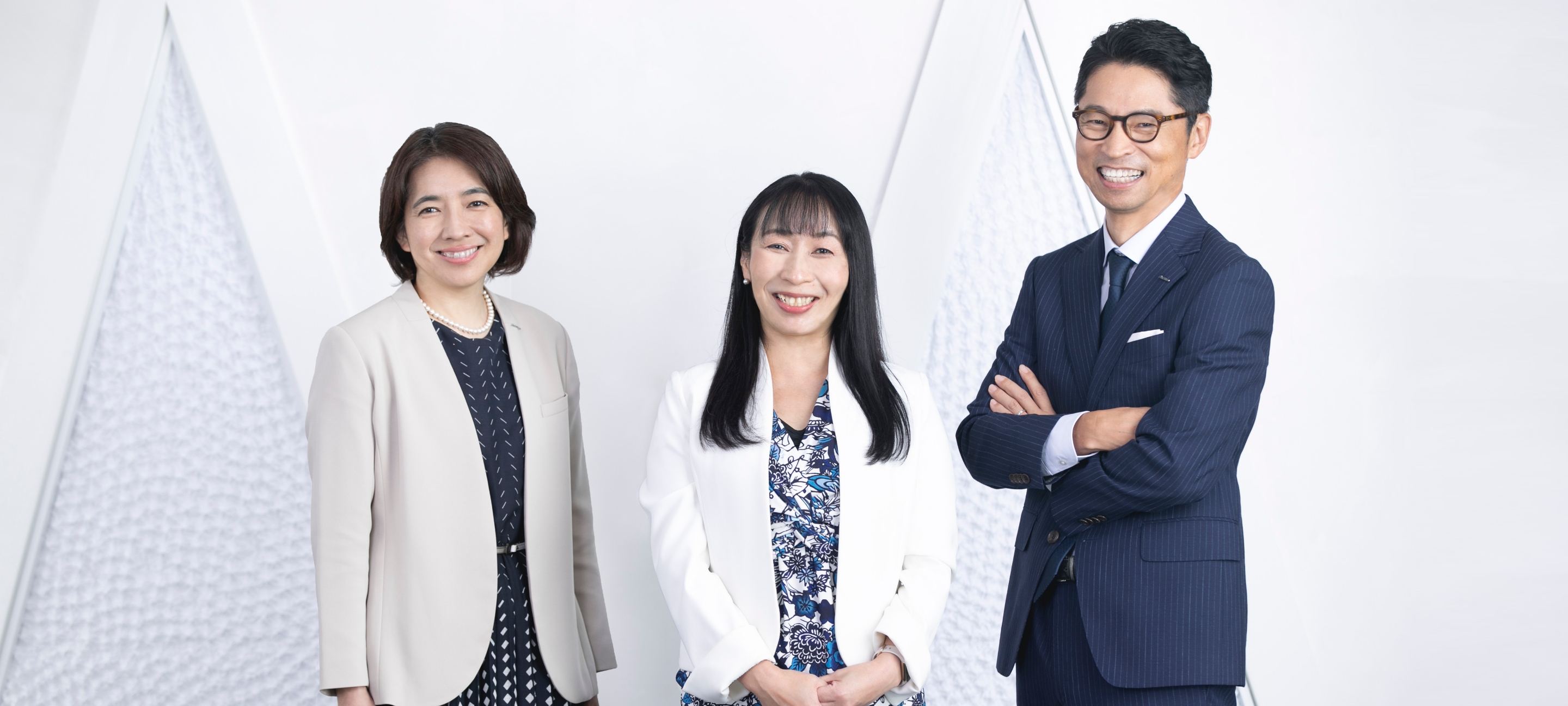
The Shiseido Female Researcher Science Grant is a project to support outstanding research by female researchers, promoted in Japan by Shiseido since 2007.
This project is broadly targeted at female researchers who have made achievements in natural sciences, based on a concept that supporting female researchers who guide the next generation will lead to the development of science and technology, with an aim to resolve the social issue that the gender gap remains large in the Science, Technology, Engineering and Mathematics (STEM) field.
Ten applicable researchers are selected every year, and one million yen is donated to each award recipient as a research grant. This grant may be spent not only for research activities, but also for research support during the life events of women, such as childbirth and childcare. This is a large characteristic of this project.
In this commemorative 15th year, a new perspective has been introduced into the review criteria: how the research contributes to the realization of a sustainable world where people around the globe can feel fulfillment and well-being, being themselves throughout their lives with the power of beauty. This is the goal for 2030 announced by Shiseido. How has this grant developed to date, and what is its outlook for the future?
This article interviews three key persons: Dr. Sachiko Matsushita, Associate Professor at Tokyo Institute of Technology School of Materials and Chemical Technology and award recipient in the 1st year as our guest, Dr. Katsunori Yoshida, Chair of Review Panel and Executive Officer at Shiseido, and Rumiko Fujiwara, Manager of Academic Relation Group in charge of overall planning and operation.
Diversity and inclusion pursued through the Shiseido Female Researcher Science Grant and its significance
―What is the background of the establishment of the Shiseido Female Researcher Science Grant?
Yoshida: I have only been in the present position for about three years, and was not engaged in the establishment of the grant in 2007. In those days, diversity and inclusion were not advocated as broadly as at present.
It must have been a major challenge to provide support focused on female researchers in that background. At that time, the overall share of female researchers in Japan was only 12%, far from being sufficient.
Shiseido considered that it would be indispensable for future society to support female researchers who would become future leaders in order to expand the base of the next generation.
We thought this way probably because the shares of female customers and stakeholders were relatively large at Shiseido as a company creating beauty.
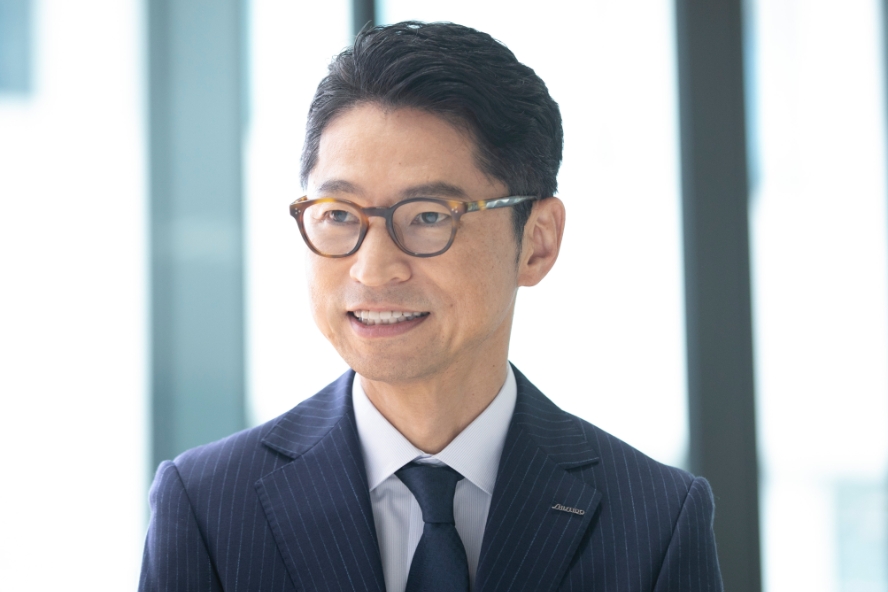
Dr. Katsunori Yoshida, Chair of Review Panel and Executive Officer at Shiseido
―Has the share of female researchers increased in the 15th year of establishment?
―The Shiseido Female Researcher Science Grant has been continued for 15 years. What value do you think participating researchers find in this project?
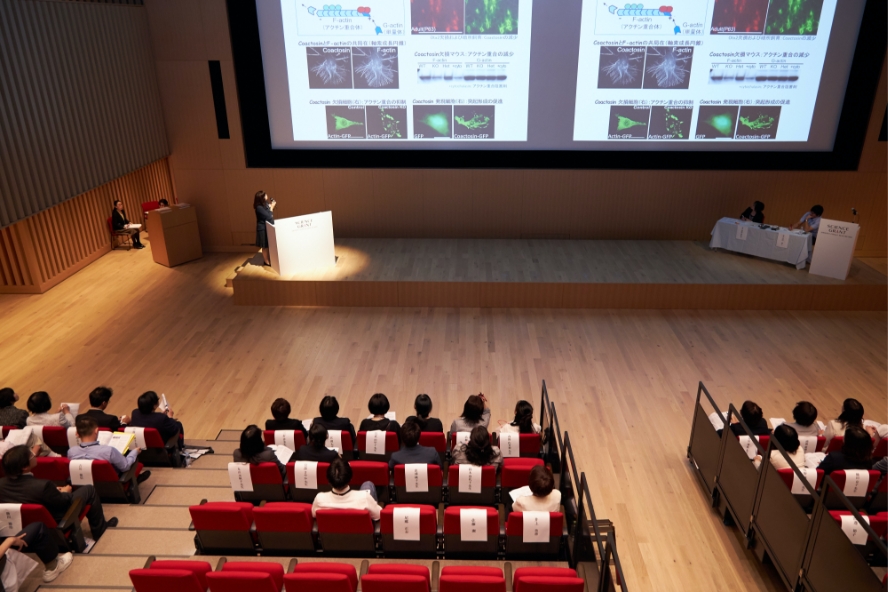
Research presentation by an award recipient
Yoshida: We have heard that the consecutive implementation of the awards for as long as 15 years has encouraged applicants and recipients.
Of course, part of this sentiment is owed to the grant itself being support funding, but award-receiving researchers seem to find larger value in the opportunity for their efforts and research outcomes to be recognized.
We feel the significance of this project when the researchers comment that they are encouraged to continue research activities. I also feel happy simply to be a part of such a project.
―That value must be priceless. As society changed over these 15 years, have issues that face female researchers also changed?
Fujiwara: Through communication with award recipients, the issue that it is difficult for women to combine their life events with the time- and effort-consuming research activities has become visible.
Although it has become a recent social trend to advocate diversity and inclusion, this perspective has yet to prevail in the settings of academia.
This is why we have enabled recipients to spend the research grant more flexibly, not only for research activities but also for sustaining their research during life events.
We have expanded the concept of research-related expenses to include, for example, employment costs obtaining necessary support during pregnancy and childbirth, baby-sitting costs, and student development costs.

Rumiko Fujiwara, Manager of Academic Relation Group
―Do you take any other measures to resolve this issue?
―I heard that a new perspective has been introduced into the review criteria in this 15th year.
Since 2019, Shiseido has announced the corporate mission, "BEAUTY INNOVATIONS FOR A BETTER WORLD." We have continued in-house discussion about what "a better world" actually means.
Through this process, we consider that people's feeling of well-being must be one of the signs of a better world. We believe that science is one of the key essences that contributes to people's happiness. I suppose many researchers who apply for the Science Grant Shiseido also hope to make people happier.
We have introduced a new perspective into the review criteria so that we can cooperate with them in realizing such a world. We would like to continue flexibly adapting to the requirements of the times in supporting researchers.
"The award had a great significance in my desperate struggle to combine research and childcare."
―We would also like to interview Dr. Sachiko Matsushita, an award recipient in the 1st year. Could you share with us what you were researching at that time and why you applied for the grant?
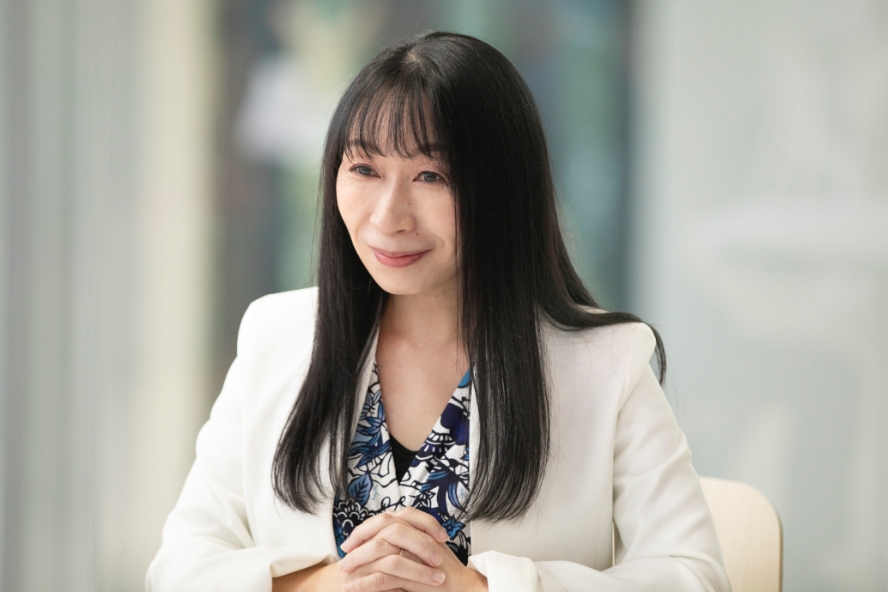
Dr. Sachiko Matsushita, Associate Professor at Tokyo Institute of Technology School of Materials and Chemical Technology and award recipient in the 1st year
Dr. Matsushita: My research was focused on attempts for the development of functional materials leveraging near-field resonance in colloidal crystals.
I am proud that this was groundbreaking research to physically apply colloidal chemistry pursuing the possibility of applying colloidal crystals as photonic crystals — new optical materials referred to as "photonic semiconductors." I received the award in June 2009. About one year prior to that, I gave birth to a child in February 2008 and returned to the lab two months after childbirth.
At that time, I was serving as the lab director at Nihon University. Even though they employed assistants for me, there were many issues that could not be adequately handled. Although it was fortunate that many students wanted to study in my lab, research activities need money.
The university had to see certain achievements. Under these circumstances, I came to know this project through the Society of Japanese Women Scientists.
I thought it was my destiny to apply for the award, because it might enable me to continue research under those circumstances.
―What did you feel after actually receiving the award?
I remember describing this way in my blog at that time.
In addition to the research grant that I received, what made me happier than anything else is that my research was recognized.
It was the largest joy that I could continue research. I felt that Shiseido encouraged me, and my path of research became clearer after receiving the award.
Did the award have any influence on your career?
I subsequently moved to the Tokyo Institute of Technology, and there have been countless occasions when the history of receiving the Shiseido Female Researcher Science Grant was effective in reassuring and persuading others.
In addition, many female students become interested in my research for receiving an award from Shiseido.
Dr. Matsushita: Now that my research activities were actually recognized by the Shiseido Female Researcher Science Grant, I became more ambitious to continue research activities while raising my young daughter.
Before I received the award, I was always concerned about whether I should continue the research activities or not. It was my small four-month-old daughter who needed me the most at that time.
I understood this better than anyone else, but still I wanted to continue research. It is not that somebody impressed anything upon me.
I was just continuously concerned about that point. Receiving the award under those circumstances made me feel as if Shiseido had authorized me to continue research, and my motivation to conduct research was substantially enhanced.
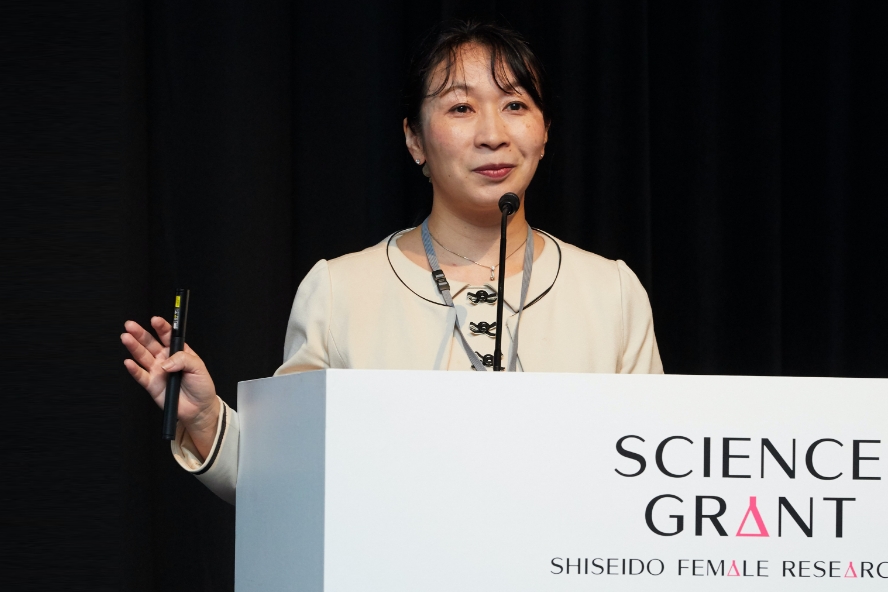
Dr. Matsushita giving a lecture at the Grant ceremony in 2018
"I hope that the Shiseido Female Researcher Science Grant functions as a community of researchers, providing an opportunity for leading innovations."
It would be just wonderful to have a forum where we can share those problems and communicate with one other.
If there is a cross-disciplinary community, as well as communities of each research field, and if the communities are categorized in many ways, researchers may be able to better communicate with one another, and even lead innovations through their interactions.
This seemed to contribute to their networking, and sometimes developed into new joint research projects.

Logo of the Shiseido Female Researcher Science Grant
Fujiwara: Through interviews with researchers, I feel that there are problems specific to female researchers.
We would like to promote and enhance this project to provide a hub of community where they can talk not only about research outcomes, but also about hurdles in the course of research.
For example, we would like to provide an environment where female researchers can feel free to consult senior award recipients when they have a problem combining research activities with life events.
I think the challenge is to create a system that can be used not only as a grant but also as a place for researchers to meet and support each other.
―In conclusion, could you describe the future outlook of the Shiseido Female Researcher Science Grant?
In the meantime, we consider the eventual goal is a society without a gender gap, where women are recognized not because they are women, but through a fair evaluation process.
The goal has not been attained from the perspective of fully exercising the abilities of female researchers not only in business enterprises but also in the settings of academia. We will make all possible efforts toward that goal.
I hope that the history of receiving the Shiseido Female Researcher Science Grant will help more women exercise their abilities in society.
I would be happy if these awards went on to relieve many people of such difficulties, just as in my case.
As Dr. Matsushita suggested earlier, we would like to invigorate the research community and enhance their network. We will endeavor to establish a platform for manifesting this vision.
Shiseido has announced a goal for 2030 to realize a sustainable world where people can feel well-being. With this goal in mind, we aim to become a "PERSONAL BEAUTY WELLNESS COMPANY" that helps each individual achieve their own healthy beauty throughout their lives.
We believe that the role of the Shiseido Female Researcher Science Grant is to maximize the possibility of science that contributes to the happiness of people. Many potentials of science have yet to be exploited.
We will continue to pursue a sustainable and better world in cooperation with researchers whom we encounter.
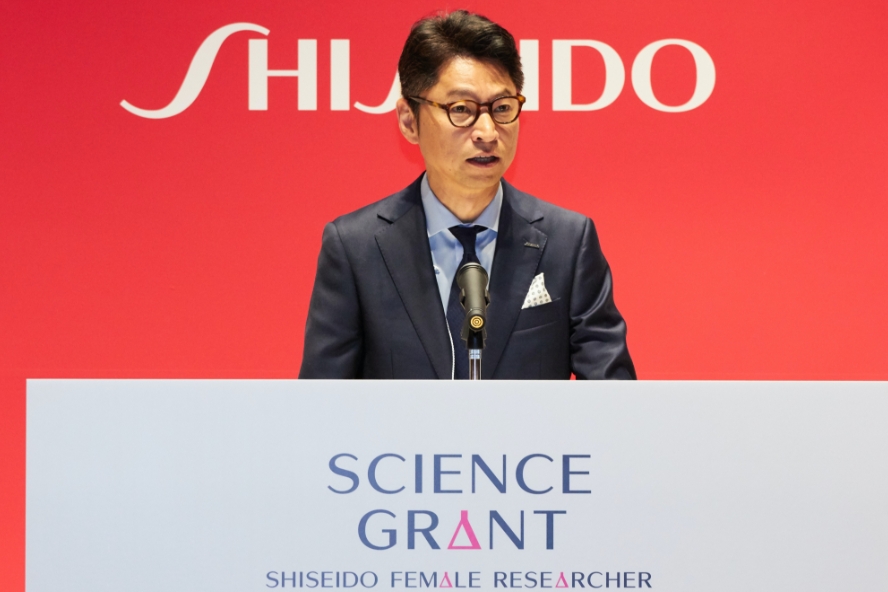
ABOUT US
- Who we are
- History
- Profile
- Governance
- Quality Management
- Supply Network
- Region/Business
BRANDS
- Prestige
- Premium
- Inner Beauty
- Life Quality Makeup
SUSTAINABILITY
- Strategy / Management
- Society
- Environment
- Governance
- Reports / Data
- Related Information
INNOVATION
- Research and Development
- Research Areas
- Research outcomes
- Product safety
- Product Development Policy
- Initiatives for doctors and researchers
CAREERS
INVESTORS
- IR Library